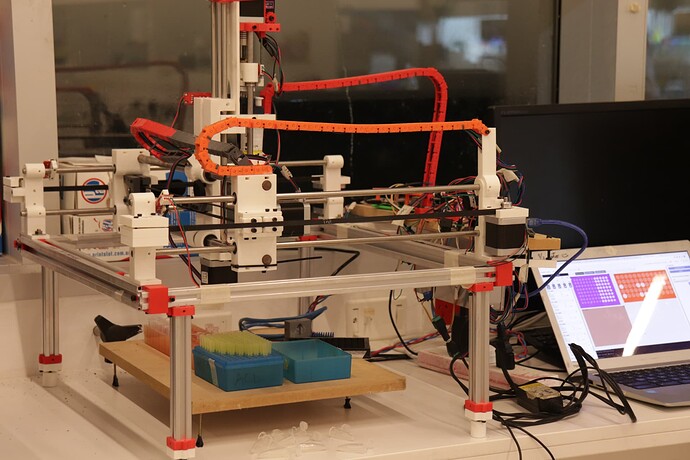Application
-
Name of applicant(s)
- Nicolás Méndez (IFIBYNE-UBA, CABA, Argentina).
- Vanesa Mercau (IFIBYNE-UBA, CABA, Argentina).
- Gastón Corthey (TECSCI S.A.S. and UNSAM, Buenos Aires, Argentina).
- Martin Gambarotta (TECSCI S.A.S., Buenos Aires, Argentina).
-
Email address (or preferred and reliable way of official contact)
- nmendez.ar@gmail.com
- vane.mercau@gmail.com
- gcorthey@unsam.edu.ar
- magambarotta@tecsci.com.ar
-
What track are you applying to? (select one):
- Our project is more relevant to the “New Project Track”, to improve an existing prototype and output an MVP.
-
Tell us about your project in one or two sentences
- The project is about making a liquid handling robot, suited to automate molecular biology protocols of low to moderate complexity, on a tight budget.
It is meant to increase reproducibility, enable experiments requiring higher throughput, and automate routine protocols; to make more with our time. - We started working on it during 2020, building upon our experience on the miniCNC project at CTA-UFGRS, during the reGOSH 2019 residence.
We now have a functional prototype in testing. It is published in a github repository, with a few demonstration videos, and uses free licences for hardware and software.
- The project is about making a liquid handling robot, suited to automate molecular biology protocols of low to moderate complexity, on a tight budget.
-
Describe your project goals and how you expect to achieve them
- Our goal is to make a system that is:
- well documented,
- easy to make, use and hack,
- extremely affordable,
- and versatile (protocol-wise).
- To these ends, we will:
- (1,2) make multimedia documentation covering most aspects of the project,
- (2,3) continue relying on widely available components, 3D printing, and modularization;
- (3) use cheaper parts and make use of existing equipment (i.e. the micropipettes),
- and (4) modularize hardware and software, implement a toolchanging system, and interface with other OScH products (thermocyclers, turbidimeters, etc.).
- We believe our project will fill a gap in OSH liquid handling robots, by fully complying with OSH definitions. Established projects like OpenTrons OT2 lack critical documentation and guides if one wishes to independently study, build, or modify the hardware. Furthermore, its purchase cost is still prohibitive for all of our region’s laboratories but the elite. We do, however, plan to make our robot compatible with the OpenTrons software and labware modules, and collaborate in the future.
- Our goal is to make a system that is:
-
Approximately how many people would be working on your project?
- Five to six people, including us applicants.
-
Describe how your oranganisation will create and manage collaboration with others.
- Subcontract calls will be public; posted on domain specific forums, employment search platforms, and shared directly with potential collaborators.
- Meeting notes, subcontract calls, collaboration logs, and expenses will also be publicly available in a GitLab repository.
- Project progress will be shared on the GOSH forum and social networks.
-
Does your project have representation for a marginalized demographic due to factors such as race, ability, place of birth, gender, sexual orientation, socioeconomic class situation or other identification? If so, how?
- The project is developed at and for a country of the “global south”.
-
What resources / infrastructure do you currently have to support your project?
- Molecular biology lab at IFIBYNE-UBA (fully equipped and funded).
- Manufacturing equipment at TECSCI S.A.S. (CNC mills, lathe, laser cutting, electronics expertise).
-
What will you use the funds for? Describe your budget. List what you are going to spend it on and how.
- See table below!
-
How will you share the outcomes your project? What documentation will you provide so that it will benefit the community as a whole? (videos? photos? a how-to?)
- All project files and documentation are released under FLOS licences.
- We prioritize the use of free/libre software tools for development (GNU/Linux, FreeCAD, KiCAD, OpenSCAD, GRBL, etc.) and documentation.
- Multimedial documentation will be published on GitLab Pages (with GitBuilding) and/or on video streaming platforms. It will thoroughly cover: assembly instructions, BOM, usage guides, hardware, software, modification guides (design rationales), part specifications and limitations, and links to relevant learning resources.
-
How will your project address GOSH’s values of diversity and inclusion?
- It aims to make laboratory automation equipment afordable to laboratories of all budgets.
- It will not discriminate against any person or group, and foster gender equality.
-
Are there any conflicts of interest that you wish to declare?
- Nope.
Our budget
| Cost Category | Details | Estimated Cost in USD | Why it’s needed |
|---|---|---|---|
| Subcontract | Industrial designer / Mechanichal egineer | 700 | Desgin components’ housing, improve/desgin new parts. Adapt an OSH toolchanging system. |
| Subcontract | Software engineer / Programmer | 700 | Review, modularize and package driver software (GUI excluded). Write driver software tests. Consider updating gerbil to support GRBL 1.1h. |
| Supplies | Components for the final prototype. | 500 | To make a full, tidy prototype with all features (adding automatic callibration and toolchanging). Build instructions will be based on it’s assembly. |
| Other expenses | Shipping costs. | 100 | Shipping costs from abroad to Argentina. |
Eye candy
Our work so far 
